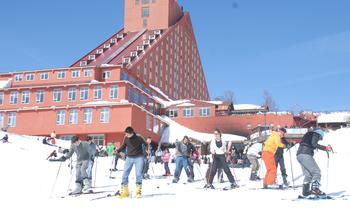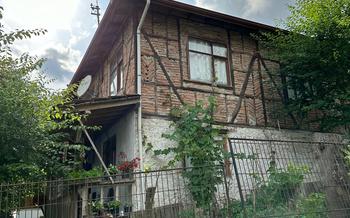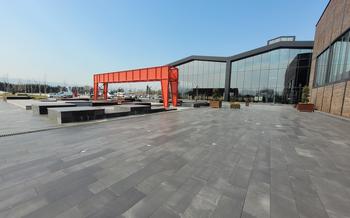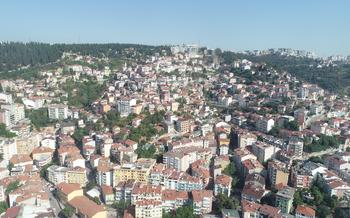
Feather Hunters Bird Paradise
- About Feather Hunters Bird Paradise
- Exploring the Park
- Bird Species to Look For:
- Other Wildlife and Nature
- Educational Programs and Activities
- Photography Opportunities
- Family-Friendly Activities
- Visitor Facilities and Amenities
- Nearby Attractions
- Getting There
- Safety and Security
- Responsible Tourism
- Cultural Insights
- Insider Tip
About Feather Hunters Bird Paradise
Established in the 1980s, Feather Hunters Bird Paradise is a sanctuary dedicated to the conservation and preservation of birds in Turkey. Spanning over 100 hectares of protected wetlands, forests, and meadows, the park provides a haven for a wide array of avian species, including migratory birds, endemic species, and even rare and endangered birds.
The park's unique location, situated at the crossroads of various bird migration routes, makes it a crucial stopover point for birds traveling between Europe, Asia, and Africa. As a result, Feather Hunters Bird Paradise has become a globally recognized destination for birdwatchers, ornithologists, and nature enthusiasts alike.
Exploring the Park
The Feather Hunters Bird Paradise is designed to provide visitors with an immersive and enriching birdwatching experience. The park features a network of well-maintained trails and boardwalks that lead visitors through diverse habitats, offering ample opportunities for birdwatching and photography.
For those seeking a guided experience, the park offers regular guided tours led by experienced naturalists and bird experts. These tours provide in-depth insights into the birdlife of the park, including bird identification, behavior, and conservation efforts. Visitors can also opt for self-guided exploration, using the park's comprehensive maps and guidebooks to navigate the trails and discover the park's avian wonders at their own pace.
Birdwatching enthusiasts can find designated birdwatching spots strategically located throughout the park, offering unobstructed views of the bird-rich habitats. These spots are equipped with comfortable seating and observation platforms, allowing visitors to relax and enjoy the spectacle of birds in their natural environment. The park also provides bird feeders and water stations to attract birds and enhance the birdwatching experience.
To ensure a harmonious coexistence with the wildlife, visitors are encouraged to follow responsible birdwatching etiquette. This includes maintaining a respectful distance from nesting sites, avoiding loud noises, and using binoculars or telescopes to observe birds without disturbing them. By adhering to these guidelines, visitors can contribute to the conservation of the park's delicate ecosystem and ensure a positive experience for all.
Bird Species to Look For:
Feather Hunters Bird Paradise is home to a diverse range of bird species, from common residents to rare and endangered visitors. Some of the most commonly spotted birds include the great tit, blue tit, chaffinch, and goldfinch. These small, colorful birds are often seen flitting through the trees and shrubs, searching for food and nesting sites.
For birdwatchers seeking a more unique experience, the park also offers the chance to spot some rarer species. The red-breasted flycatcher is a striking bird with a bright red breast and black plumage. It is a migratory species that can be seen in the park during the summer months. Another rare visitor is the hoopoe, a distinctive bird with a long, curved beak and a colorful crest.
Seasonal variations in bird populations also add to the diversity of the park. During the spring and summer months, many migratory birds arrive in the park to breed and raise their young. These include the nightingale, oriole, and bee-eater. In the winter, the park hosts a variety of waterfowl, such as the mallard, teal, and coot.
Each bird species in the park has its own unique characteristics and behaviors. The great spotted woodpecker can be seen drumming on tree trunks in search of food, while the mistle thrush sings its loud, melodious song from the treetops. The grey heron stands patiently in the shallows, waiting for fish to swim by, and the kestrel hovers in the air, scanning the ground for prey.
Identifying and photographing birds can be a rewarding experience for birdwatchers of all levels. With a little patience and practice, visitors to Feather Hunters Bird Paradise can learn to recognize the different species and capture stunning images of these beautiful creatures.
Other Wildlife and Nature
Beyond the diverse birdlife, the Feather Hunters Bird Paradise is home to a variety of other wildlife and natural wonders. Mammals such as foxes, rabbits, and squirrels can be spotted amidst the trees and shrubs. Reptiles like lizards and turtles bask in the sun along the water's edge, while amphibians, including frogs and salamanders, thrive in the park's diverse habitats.
The bird paradise is also a haven for plant species. From towering oak and pine trees to delicate wildflowers, the park's diverse vegetation provides food and shelter for its animal inhabitants. Native plants like the Turkish hazel and the Anatolian oak play a crucial role in maintaining the delicate balance of the ecosystem.
The park's varied habitats, including forests, wetlands, and grasslands, support distinct ecosystems. These habitats provide unique niches for different species to thrive, contributing to the park's rich biodiversity. The park's conservation efforts extend beyond birdlife, encompassing the protection and preservation of all wildlife and their habitats.
Sustainability and conservation initiatives are at the forefront of the park's management practices. Visitors are encouraged to adopt responsible tourism practices, such as using designated trails, avoiding littering, and respecting wildlife. Educational programs and events aim to raise awareness about the importance of conservation and the interconnectedness of the park's diverse ecosystems.
Educational Programs and Activities
Feather Hunters Bird Paradise offers a range of educational programs and activities that cater to all ages and interests. Visitors can participate in workshops, seminars, and birdwatching courses led by experienced ornithologists and educators. These programs cover topics such as bird identification, bird behavior, and conservation practices.
Birdwatching competitions and events are organized throughout the year, providing opportunities for participants to test their skills and knowledge while contributing to the conservation of birds. The bird paradise also offers volunteer opportunities and citizen science projects, allowing visitors to get involved in hands-on conservation work and contribute to valuable research.
Educational materials and resources are available for visitors of all ages, including books, brochures, and interactive exhibits. These resources help visitors learn about the diverse bird species found in the park, their unique characteristics, and the importance of protecting their habitats.
Photography Opportunities
Feather Hunters Bird Paradise is a haven for bird photographers, offering ample opportunities to capture stunning images of a wide variety of bird species. Here are some tips for aspiring bird photographers:
-
Choose the Right Equipment: Invest in a high-quality camera with a telephoto lens. A DSLR or mirrorless camera with a focal length of at least 300mm is recommended for capturing detailed shots of birds.
-
Master Camera Settings: Familiarize yourself with your camera's settings, including aperture, shutter speed, and ISO. Experiment with different settings to achieve the desired depth of field, motion blur, and overall exposure.
-
Respect Bird Habitats: Be mindful of the impact your presence may have on the birds. Keep a safe distance and avoid disturbing their natural behaviors. Use a camouflage hide or blind to minimize your visibility.
-
Patience is Key: Bird photography requires patience and perseverance. Be prepared to spend hours waiting for the perfect shot. Observe the birds' patterns and behaviors to anticipate their movements.
-
Capture Natural Moments: Avoid using flash photography, as it can startle the birds. Instead, rely on natural light to capture authentic and candid shots. Look for interesting compositions and backgrounds to enhance your images.
-
Join a Photo Tour: Consider joining a guided photo tour led by an experienced bird photographer. These tours often provide access to exclusive locations and guidance on capturing the best shots.
-
Share Your Work: Share your bird photographs with others to inspire and educate them about the beauty and diversity of the avian world. Participate in bird photography competitions and exhibitions to showcase your skills.
Family-Friendly Activities
Feather Hunters Bird Paradise is not just a haven for bird enthusiasts; it also offers a range of family-friendly activities that make it a perfect destination for visitors of all ages. Children can explore the park's dedicated play areas, which feature interactive exhibits and educational games that teach them about the fascinating world of birds. There are also birdwatching games and activities designed specifically for kids, helping them to engage with nature and develop a love for birdwatching.
Families can participate in educational workshops and events tailored to children, where they can learn about bird identification, bird behavior, and the importance of conservation. These programs not only provide a fun and educational experience but also create lasting memories for families to cherish.
Designated picnic areas and rest stops within the park allow families to take a break, enjoy a packed lunch surrounded by nature, and recharge for further exploration. These areas offer a chance to relax, bond, and share stories about their birdwatching adventures.
Visitor Facilities and Amenities
Feather Hunters Bird Paradise provides a range of visitor facilities and amenities to enhance your experience. As you explore the park, you'll find a well-stocked gift shop where you can purchase souvenirs, birdwatching guides, and other items to commemorate your visit. If you need a break from birdwatching, the cafeteria offers a variety of refreshments, including snacks, beverages, and light meals. There are also designated picnic areas where you can enjoy a packed lunch surrounded by nature.
For your convenience, restrooms and changing facilities are available throughout the park. To ensure a comfortable visit for all, the bird paradise is wheelchair accessible, with designated parking spaces and accessible routes. Visitors with disabilities can also request assistance from the friendly and knowledgeable staff.
Nearby Attractions
Feather Hunters Bird Paradise is situated in a region teeming with natural attractions that could rival it in beauty and diversity. For the ones who love nature as much as birds do, there are a number of other birdwatching spots in the Kocaeli region that are worth exploring. The Gulf of Izmit, a short drive from the bird paradise, is an excellent spot to observe migratory birds, particularly during the spring and fall.
If you are interested in delving into the rich history and culture of the region, there are numerous historical sites and cultural attractions within easy reach of the bird paradise. The city of Izmit, just a few kilometers away, is home to a number of historical landmarks, including the Izmit Clock Tower, the Kocaeli Museum, and the historic district of Çukurbağ.
Furthermore, Kocaeli is blessed with an abundance of natural landmarks and scenic viewpoints that offer breathtaking vistas. Kartepe Mountain, with its lush forests and panoramic views, is a popular destination for hikers and nature enthusiasts. The Sapanca Lake, with its crystal-clear waters and picturesque surroundings, is another must-see attraction for those who love the outdoors.
Last but not least, Kocaeli is also a great place to delve into local cuisine and culinary experiences. The region is famous for its delicious fresh seafood, traditional Turkish dishes, and delectable desserts. Visitors can indulge in a culinary journey by sampling the local specialties at the many restaurants, cafes, and markets that dot the area.
Getting There
Feather Hunters Bird Paradise is conveniently accessible from major cities like Istanbul, Ankara, and Bursa. If you're driving, take the D-100 highway and follow the signs to Kocaeli. The bird paradise is well-signposted, and ample parking is available on-site.
For those without a car, public transportation is an excellent option. Regular buses depart from Istanbul's Esenler Bus Terminal and Ankara's Aşti Bus Terminal, directly to Kocaeli. From there, you can take a local bus or taxi to the bird paradise.
Guided tours are also available from various tour operators in Istanbul and Ankara. These tours typically include transportation, entrance fees, and a knowledgeable guide who can help you spot and identify different bird species.
Visitors with disabilities can access the bird paradise through designated ramps and walkways. Accessible restrooms and parking facilities are also available.
Safety and Security
Feather Hunters Bird Paradise prioritizes the safety and security of its visitors. Here are some guidelines to ensure a safe and enjoyable experience:
-
Respect Wildlife: Maintain a safe distance from birds and other wildlife, and avoid disturbing their natural behaviors. Observe animals from designated viewing areas.
-
Stay on Designated Trails: Follow marked trails and pathways to minimize your impact on the environment and avoid disturbing wildlife habitats.
-
Be Aware of Your Surroundings: Stay alert and aware of your surroundings, especially when walking near bodies of water or in dense vegetation. Be cautious of slippery surfaces and uneven terrain.
-
Emergency Preparedness: Familiarize yourself with emergency contact information and first aid services available at the park. Carry a fully charged mobile phone and a basic first aid kit.
-
Report Incidents: If you encounter any safety concerns, suspicious activities, or wildlife disturbances, promptly report them to park staff or authorities.
-
Personal Safety: Avoid venturing into secluded areas alone. Inform park staff or a companion about your planned route and estimated return time.
-
Respect Local Customs: Be mindful of local customs and traditions related to wildlife and nature. Observe any regulations or restrictions regarding birdwatching or wildlife photography.
By following these safety guidelines, you can help protect yourself, wildlife, and the environment while enjoying your visit to Feather Hunters Bird Paradise.
Responsible Tourism
Feather Hunters Bird Paradise is committed to promoting responsible tourism practices that minimize environmental impact and support the local community. Visitors are encouraged to follow these guidelines:
- Respect the natural environment: Avoid littering, disturbing wildlife, or damaging plants and trees. Stay on designated trails and avoid venturing into sensitive areas.
- Minimize noise and light pollution: Birds are sensitive to noise and light, especially during nesting and feeding. Keep conversations to a low volume, turn off flashlights and other bright lights, and avoid using loud equipment.
- Support local businesses: Patronize local restaurants, shops, and tour operators to support the local economy. This helps to create a sustainable tourism industry that benefits the community and the environment.
- Educate yourself and others: Learn about the importance of bird conservation and share your knowledge with others. Encourage friends, family, and fellow travelers to adopt responsible tourism practices.
- Report any violations: If you witness any violations of park rules or regulations, report them to park staff immediately. This helps to ensure that the bird paradise remains a safe and sustainable environment for birds and visitors alike.
Cultural Insights
Birdwatching in Turkey is not just a hobby but a deeply ingrained cultural practice with historical roots and symbolic significance.
-
Birds hold a special place in Turkish mythology and folklore, appearing in legends, tales, and proverbs.
-
The iconic "Phoenix" bird, known as "Anka" in Turkish, symbolizes rebirth, transformation, and hope.
-
The "Forty Birds" (Kirk Kus) legend depicts a group of birds who carry the souls of the deceased to the afterlife.
-
Birdwatching festivals and cultural events, such as the "Bird Festival" in Izmir, celebrate the diversity and beauty of Turkey's avian population.
Experience the unique cultural dimensions of birdwatching in Turkey by engaging with local birdwatchers and learning about their traditions, beliefs, and stories.
Insider Tip
Secret Birdwatching Spots Off the Beaten Path:
Venture beyond the main trails to discover hidden gems within the Feather Hunters Bird Paradise. Explore the secluded corners of the park, such as the marshy wetlands or the dense forests, to encounter rare and elusive bird species that may not frequent the more popular areas. These hidden spots offer a tranquil and intimate experience, allowing you to immerse yourself in the beauty and diversity of the park's avian inhabitants.
Tips for Spotting Rare and Elusive Bird Species:
Patience and perseverance are key to spotting rare and elusive bird species. Visit the park during the early morning or late evening hours when birds are most active. Stay quiet and still, using binoculars or a spotting scope to scan the trees, bushes, and water bodies. Look for signs of movement, such as rustling leaves or ripples in the water, which may indicate the presence of a bird.
Best Times of Day for Birdwatching:
The best times of day for birdwatching at Feather Hunters Bird Paradise are early morning and late afternoon. During these periods, birds are most active, feeding and singing. As the sun rises, the air is still, making it easier to spot and photograph birds. In the evening, the golden light casts a warm glow on the landscape, creating a magical atmosphere for birdwatching.
Unique Experiences and Hidden Gems Within the Bird Paradise:
Beyond birdwatching, the Feather Hunters Bird Paradise offers unique experiences and hidden gems for visitors to discover. Participate in guided night walks to witness the nocturnal wonders of the park, including owls, nightjars, and bats. Attend birdwatching workshops to learn more about bird identification and photography. Embark on a boat tour to explore the park's waterways and observe waterbirds in their natural habitat.









